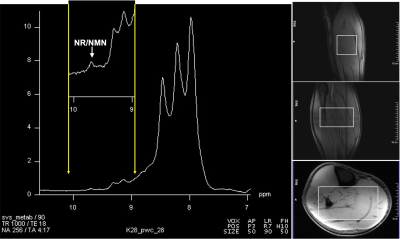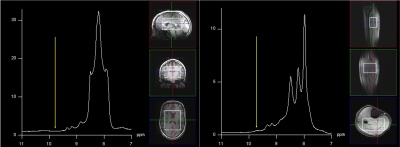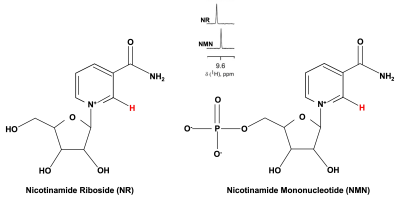0409
Detection of a new resonance in human calf muscle in vivo at 7.0T using the down-field MRS1Radiology, Center for Advance Metabolic Imaging in Precision Medicine, Perelman School of Medicine at The University of Pennsylvania, Philadelphia, PA, United States, 2Bioengineering, University of Pennsylvania, Philadelphia, PA, United States
Synopsis
We have detected a resonance that was not reported previously, with a chemical shift of ~9.7ppm occurring in down-field MRS (DFMRS) from the human calf muscle in vivo. Based on phantom data, we speculate that the contribution to this broad peak might be from nicotinamide riboside (NR) and nicotinamide mononucleotide (NMN). This is for the first time that this peak is observed and reported from the down-field spectra. It seems to be very specific to calf muscle and has not been identified from the down-field spectra of human brain in vivo, suggesting that it is a feature of muscle metabolism.
INTRODUCTION
Downfield MR spectroscopy (DFMRS) is an emerging technique for detection of in vivo metabolites with protons that resonate >4.7 ppm. While several metabolites such as NAD+ and carnosine have previously been characterized in the downfield MR spectrum of calf muscle, it is unclear if there are other previously unidentified resonances that might be detected in vivo. Since most of the DF metabolites have protons that cross-relax with water, typically non-water suppressed methods are used to perform DFMRS1-4. In the current study while performing downfield MRS studies at 7.0T, we have detected a new resonance that was previously not reported and seems to be specific to calf muscle. Preliminary results obtained from healthy human calf muscle are presented here.METHODS
Five subjects (4 Male, 1 Female) in the age range of 22-33Y participated in the IRB approved study after explaining the study protocol and obtaining the consent form. All the downfield 1HMRS data were obtained at 7.0T Siemens Terra scanner (Siemens Healthcare, Erlangen, Germany) using a single-channel transmit/28-channel receive phased array knee radio frequency coil (Quality Electrodynamics, Mayfield Village, OH, USA). A spectrally selective 90° E-BURP pulse5 centered at 9.1ppm with a band width of 2 ppm was used to excite the downfield metabolites (TR/TE: 1000/18ms, 256 averages, BW: 600Hz), and 3 narrow spatially selective refocusing 180° Shinnar-Le Roux (SLR) pulses (BW: 800Hz) were used for localization as described in our previous study3. A large voxel of 50x90x50 mm3 was positioned within the calf to cover the maximum muscle area as shown in Figure 1. The voxel dimensions varied across the volunteers to cover their maximum muscle area.RESULTS
A representative voxel from which the DFMRS was acquired from the calf muscle of one of the volunteers in vivo is shown in Figure 1. With this larger voxel acquisition the scan time is significantly reduced to ~7 min including the water scans rather than the longer acquisition time with the traditional smaller voxel. In all the five volunteers scanned, we have consistently identified a broad peak with peak center at ~9.7ppm. A representative spectrum from one of the volunteers is shown in Figure 2 and within inset is the new identified peak at ~9.7ppm. This new peak seems to be specific to calf muscle metabolism as same was not identified in the down field spectra of the human brain in vivo with similar voxel size as shown in Figure 3.DISCUSSION
This is for the first time we have identified an additional new peak at ~9.7ppm in the down-field spectra of calf muscle in vivo at 7.0T, not previously reported. This resonance appears to be a feature of muscle metabolism. Recently published studies from human cell extracts and whole blood assay suggest that the new resonance we have identified could be from Nicotinamide ribose (NR) although Nicotinamide mononucleotide (NMN) could also be not ruled out as the Nicotinamide ring proton located on carbon between the pyridine ring nitrogen and the amide resonates at around 9.64 and 9.6ppm, respectively6,7, the chemical structures of which along with proton chemical shift of the said resonance from the phantom of one of the published study6 are shown in Figure 4. This makes complete sense as the NR is a NAD precursor, which is converted to NMN and subsequently to NAD+. We are in the process of confirming this finding using muscle tissue samples and phantoms of the potential metabolites with expected resonances in the desired chemical shift range. Also, further studies are ongoing to confirm the cross-relaxation between the newly identified peak and water in vivo. However, the reason why we see this particular resonance in down-field spectra of calf muscle but not in the brain is a topic of further investigation.CONCLUSION
This is the first ever reported finding of a new resonance at ~9.7ppm in the DFMRS that is specific to calf muscle at 7.0T. We speculate that this peak may be from Nicotinamide riboside although the contribution of Nicotinamide mononucleotide cannot be ruled out.Acknowledgements
Research reported in this publication was supported by the National Institute of Biomedical Imaging and Bioengineering of the National Institutes of Health under award Number P41EB029460 and by the National Institute of Aging of the National Institute of Health under award Number R56AG062665.References
1. de Graaf RA, Behar KL. Detection of cerebral NAD(+) by in vivo (1)H NMR spectroscopy. NMR Biomed. 2014;27:802-809.
2. de Graaf RA, De Feyter HM, Brown PB, et al. Detection of cerebral NAD+ in humans at 7T. Magn Reson Med. 2017;78:828-835.
3. Bagga P, Hariharan H, Wilson NE, et al. Single-voxel 1H MR spectroscopy of cerebral nicotinamide adenine dinucleotide (NAD+) in humans at 7T using a 32-channel volume coil. Magn Reson Med. 2020;83:806-814.
4. Bagga P, et al. In vivo detection of NAD+ in human calf muscle at 7T using 28 channel knee volume coil at 7T. ISMRM&SMRT Annual Meeting and Exhibition 2018.
5. Geen H, Freeman R. Band-selective radiofrequency pulses. J Magn Reson. 1991;93:93-141.
6. Shabalin k, Nerinovski K, Yakimov A, et al. NAD metabolome analysis in human cells using 1HNMR spectroscopy. Int J Mol Sci. 2018;19:3906.
7. Airhart SE, Shireman LM, Risler LJ, et al. An open-label, non-randomized study of the pharmacokinetics of the nutrional supplement nicotinamide riboside (NR) and its effects on blood NAD+ levels in healthy volunteers. PLoS ONE 2017;12:e0186459.
Figures



